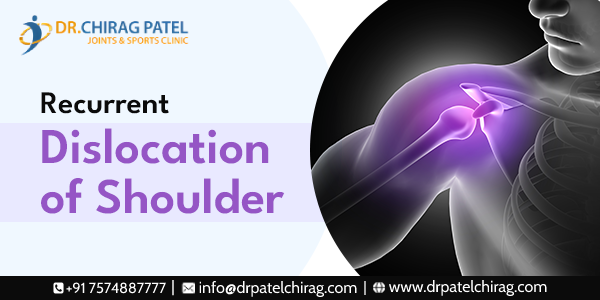Types, Causes & Treatment Options by Dr Chirag Patel
Recurrent dislocation of shoulder – The shoulder is the most mobile and, as a result, the most vulnerable joint in the human body. Due to its hypermobility and vulnerability, no other joint is more susceptible to injury than the shoulder, especially in sports.
As a sports injury specialist in Mumbai, Dr. Chirag Patel treats thousands of sports injuries every year, and shoulder injuries top the list. Whether caused by sports activities or regular daily tasks, shoulder dislocations affect many individuals. A condition known as recurrent shoulder dislocation is a crucial contributor to this anomaly. If you constantly experience shoulder dislocation issues even with a low-intensity workload, recurrent shoulder dislocation could be the underlying reason.
But what exactly is recurrent shoulder dislocation, its causes, and how is it treated? Orthopaedic surgeon and shoulder specialist Dr. Chirag Patel has the answers.
What is recurrent dislocation of shoulder, and what causes it?
Shoulder dislocation happens when the ball of the shoulder joint is completely displaced from its socket. In most cases, shoulder dislocation occurs due to a fall on the outstretched hand, a direct blow to the shoulder joint. In rare cases, shoulder dislocation can happen due to non-athletic activity in persons who suffer from inherently loose joints.
Shoulder dislocation can also happen in athletes of sports where the shoulder takes a lot of stress (throwing). The repetitive motion in these sports can eventually dislocate the shoulder wholly or partially. The shoulder, once dislocated, has a higher chance of dislocation. Based on the cause and patient, it can happen multiple times for minor inconvenience in the joint, and this repeated shoulder dislocation is called recurrent shoulder dislocation.
People suffering from chronic shoulder instability tend to suffer from recurrent shoulder dislocation. Shoulder dislocation caused by a traumatic incident may lead to shoulder instability, which triggers shoulder dislocation.
Shoulder Joint Dislocation Types:
The shoulder joint’s ball can dislocate in any direction. When it dislocates to the front, it’s called anterior dislocation; to the back, posterior dislocation; and below the socket, inferior dislocation. “Shoulder dislocation can also happen in a combination of different directions, and this dislocation is called multi-directional dislocation, which happens in patients with loose joints,” said shoulder specialist in Mumbai, Dr. Chirag Patel.
Recurrent Dislocation of Shoulder & Its Treatment
The shoulder dislocated for the first time is restored to its natural position without surgery. One may need anaesthesia or some form of sedative during this procedure. The shoulder is immobilized by keeping it close to the chest using a sling to enable healing. High-demand athletes or younger patients will need surgery to repair the site to prevent this dislocation.
Treatment for recurrent shoulder dislocation varies and demands surgery, though. For patients with a sedentary lifestyle, whose shoulder is not prone to strenuous activities, non-surgical treatment may suffice to treat recurrent dislocation. But for athletes and patients with an active lifestyle, surgery is prescribed by shoulder specialists in Mumbai.
Keyhole surgery is a minimally invasive surgery that can be performed to tighten the lax capsule and reattach the dislocated components. Open surgery is another surgical method that involves transition incision-based surgery to repair the dislocated parts. In cases of bone loss, a bone graft can further improve the shoulder’s functional and anatomical position using a specialized surgical procedure called the Bristow-Latarjet procedure.





